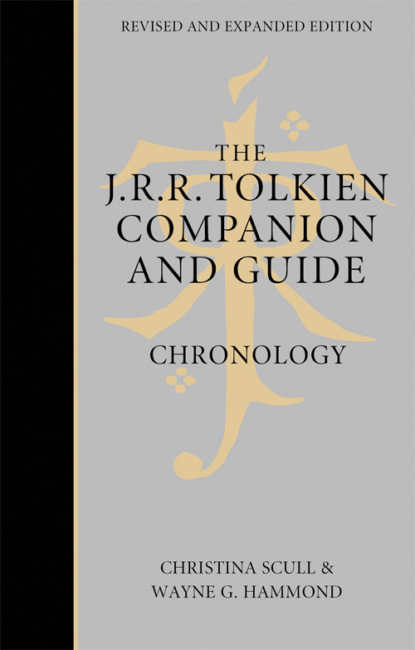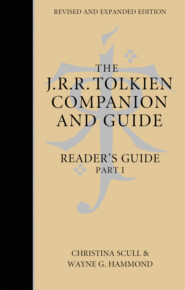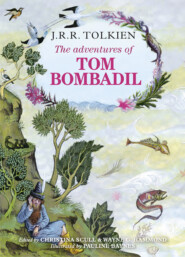По всем вопросам обращайтесь на: info@litportal.ru
(©) 2003-2024.
✖
The J. R. R. Tolkien Companion and Guide: Volume 1: Chronology
Настройки чтения
Размер шрифта
Высота строк
Поля
19 September 1915 R.W. Reynolds writes to Tolkien at Whittington Heath and thanks him for sending his poems. He likes all of them, though he makes some criticisms. He wonders if Tolkien has thought of a new title for his book.
Autumn 1915 Tolkien and a fellow officer buy a motor cycle. Tolkien will use it to visit Edith and friends when he has leave.
21 September 1915 Gilson writes from Marston Green to Tolkien at Whittington Heath. He has sent telegrams to Wiseman and Smith asking them to come to Lichfield on Saturday (25 September) if possible.
23 September 1915 Wiseman, now at the Royal Naval College, Greenwich, writes to Tolkien at Whittington Heath. He intends to be present at the ‘Council of Lichfield’ on 25–26 September. – Gilson, who has heard from Smith, writes to Tolkien that all four T.C.B.S. members can be in Lichfield on 25 September, and asks if Tolkien can find three beds there for the night. He suggests that they have lunch the following day at the Gilsons’ home at Marston Green and a quiet afternoon in the garden.
24 September 1915 Gilson informs Tolkien by telegram that he and Smith will arrive in Lichfield at 10.34 am on the 25th and make the George Hotel their headquarters.
25 September 1915 At 11.00 a.m. Gilson and Smith write to Tolkien from the George Hotel, Lichfield. They hope to meet him at the hotel when they return from sightseeing just before 1.00 p.m., if not sooner. – O.O. Staples, B.J. Tolhurst, and M.W.M. Windle of Exeter College are killed in action in the Battle of Loos.
25–26 September 1915 The T.C.B.S. ‘Council of Lichfield’. This is the last time that Tolkien, Gilson, Smith, and Wiseman meet together before being separated by war, and apparently the last time that Tolkien sees Gilson.
5 October 1915 Gilson, now with his battalion at No. 2 Camp, Sutton Veny, writes to Tolkien. He and Smith have decided that Tolkien should send his book of poems to the publisher Sidgwick & Jackson. Tolkien should not forget the proposed ‘Council of Bath’, and should try to keep both 16 and 23 October as possible dates.
6 October 1915 Smith writes to Tolkien from the York House Hotel, Bath. Smith and Gilson are making a preliminary excursion to Bath and have practically engaged inexpensive rooms in the South Parade for a T.C.B.S. ‘council’ on 23 October.
9 October 1915 Smith writes to Tolkien that he is sorry he has not had time to reply to Tolkien’s impressive postcard. He recommends that Tolkien send his poems to the publisher Hodder and Stoughton, or to Sidgwick & Jackson, and asks for copies of Tolkien’s later poems so that he can show them to H.T. Wade-Gery.
19 October 1915 Smith, now at No. 6 Camp, Codford St Mary, Wiltshire, writes to Tolkien. Tolkien should let him know as soon as possible if he is coming to Bath, and inform Gilson by telegram so that he can book rooms. – Gilson writes from No. 3 Camp, Sutton Veny, to Tolkien at Brocton Camp, *Staffordshire, forwarded to him at Penkridge, Rugeley (i.e. Rugeley Camp on Cannock Chase). See note. Gilson is likely to be sent to the front very soon, and if at all possible would like the T.C.B.S. to meet the next weekend.
24 October 1915 Smith writes to Tolkien at Whittington Heath from the Wisemans’ house in London. He has heard from Tolkien that he cannot join them for the weekend. Tolkien seems to have been depressed about various matters, one of which is that Edith is ill. Smith thanks Tolkien for sending more poems and is particularly impressed with The Happy Mariners and Dark Are the Clouds about the North. Smith and Gilson have not gone to Bath, but on impulse have joined Wiseman in London. There they have reaffirmed the principles of the T.C.B.S. and have decided ‘once again on the work it will have to do after the war is over: to drive from life, letters, the stage and society that dabbling in and hankering after the unpleasant sides and incidents in life and nature which have captured the larger and worser tastes in Oxford, London and the world: … to reestablish sanity, cleanliness, and the love of real and true beauty in everybody’s breast’ (Tolkien Papers, Bodleian Library, Oxford).
27 October 1915 Wiseman writes to Tolkien, giving an account of the previous weekend.
31 October 1915 Gilson writes to Tolkien at Whittington Heath, giving his account of the weekend 23–24 October. He was very sorry that Tolkien could not come; he feels that the T.C.B.S. is not complete unless all four are present.
November 1915 Tolkien moves with the 13th Battalion to Rugeley Camp in Staffordshire. – G.B. Smith goes to France with the 19th Lancashire Fusiliers.
November 1915–early 1916 While stationed at Cannock Chase Tolkien takes the opportunity to visit Phoenix Farm, Gedling. Colin Brookes-Smith will later recall that Tolkien arrived on an AJS motor cycle, and one morning allowed Colin to ride it up the road and back. Probably during this period Tolkien also participates in the cutting up of a poached deer, an event to which he will later refer during lectures on Sir Gawain and the Green Knight at Oxford. See note.
?21–28 November 1915 Tolkien writes a poem, Kortirion among the Trees (*The Trees of Kortirion); one of its earliest copies will be inscribed ‘dedicated to Warwick’. A fair copy will be dated ‘Nov. 21–28’, and a later typescript inscribed ‘Warwick, a week’s leave from camp – written largely in a house in Victoria Street [where Edith and Jennie Grove live] and in [mine?] in Northgate St.’ In fact Tolkien is in camp on 25 and 26 November, from which he writes on each date to Edith (see below), and in the second letter says that he has ‘written out a pencil copy of “Kortirion”’ (Letters, p. 8). This suggests that Edith knows about the work already, that Tolkien may have begun the poem during a visit to Warwick and continued to work on it when he returned to camp, and that after writing out the pencil copy on 26 November he made further alterations (27–28 November) before making the dated fair copy. – To a fair copy of the poem Tolkien will append a prose introduction which explains that Kortirion was a city of the fairies (later Elves) in the Lonely Isle ‘after the great wars with Melko and the ruin of Gondolin’, built ‘in memory of their ancient dwelling of Kôr in Valinor’ (The Book of Lost Tales, Part One, p. 25). It is clear that he intends Warwick to be the site where earlier had stood Kortirion, whose memory still lingers, and his mythology to be particularly connected with England (the ‘Lonely Isle’). Although the date of this prose introduction is uncertain, its sentimental yet hopeful tone, so like that of the poem, suggests that both were written at roughly the same time. If that is so, several very notable elements have been added by Tolkien to his rapidly growing mythology. On one early copy he gives the poem a subsidiary (but not entirely legible) title in Qenya, Narqelion la . . tu y aldalin Kortirionwen, ‘Autumn (among) the Trees of Kortirion’. On one of the surviving working sheets he drafts four lines of a poem in Qenya on a similar theme (*Narqelion). By now, Tolkien has developed his invented language to the extent that he is able to use it in composition.
21 November 1915 Gilson writes to Tolkien that the last he has heard from him is a letter Smith showed him in London. He hopes that Tolkien is no longer depressed and that Edith is now better. – Hilary Tolkien lands in Boulogne with the Royal Warwickshire Regiment.
25 November 1915 Tolkien writes to Edith from Rugeley Camp.
26 November 1915 Tolkien writes to Edith from Rugeley Camp, giving an account of his day:
The usual kind of morning standing about and freezing and then trotting to get warmer so as to freeze again. We ended up by an hour’s bomb-throwing with dummies. Lunch and a freezing afternoon. All the hot days of summer we doubled about at full speed and perspiration, and now we stand in icy groups being talked at! Tea and another scramble − I fought for a place at the stove and made a piece of toast on the end of a knife: what days! [Letters, p. 8]
He has written out a pencil copy of Kortirion among the Trees; he first intends to send it to the T.C.B.S. as he owes them all letters, then decides that he will send it to Edith and make another copy for the T.C.B.S.
28 November–4 December 1915 Tolkien writes a poem, The Pool of the Dead Year (and the Passing of Autumn).
December 1915 Tolkien moves with the 13th Battalion to Brocton Camp on Cannock Chase.
1 December 1915 Tolkien’s poem Goblin Feet is published in Oxford Poetry 1915. The volume also includes ‘Songs on the Downs’ by G.B. Smith and three poems by H.T. Wade-Gery.
2 December 1915 Smith, now in the trenches in France, writes to Tolkien in care of the 13th Lancashire Fusiliers, 3rd Reserve Brigade, Officers Company, Brocton Camp. He asks for the long letter Tolkien promised in his last postcard that he would send.
20 December 1915–9 January 1916 British and allied troops evacuate Gallipoli.
22 December 1915 Smith writes to Tolkien, thanking him for various letters and commenting on Oxford Poetry 1915 and Goblin Feet. Smith and Wade-Gery agree that they and Tolkien are the best contributors to the volume.
26 December 1915 Gilson writes to Tolkien in care of the 3rd Reserve Brigade, Officers Company, P Lines, Brocton Camp. Tolkien has written to him about some problems, as Gilson remarks on ‘the extra blackness of your fate in these dark days’ (Tolkien Papers, Bodleian Library, Oxford). He has just forwarded Kortirion among the Trees to Wiseman, and has made a copy for Smith. He likes the poem very much though he makes one or two criticisms.
30 December 1915 Wiseman writes to Tolkien at Brocton Camp. He has been posted to the HMS Superb. He has received Kortirion among the Trees from Gilson, and will write about it later.
1916 (#ulink_4277d0e6-58c7-58b7-87d5-335b922843e9)
1916 Tolkien paints a watercolour, The Day after the Day after Tomorrow. On the verso of the sheet is another picture, Wrenching a Slow Reluctant Truth, presumably done at same time.
?January–February 1916 Tolkien writes *Over Old Hills and Far Away, another ‘fairy’ poem about the piper Tinfang Warble. The manuscript has an apparently contemporaneous note, ‘Jan[uary]–Feb[ruary] 1916’. A later typescript of the poem will be inscribed ‘Brocton Camp, Christ[mas]–Jan[uary] 1915–16’.
7 January 1916 Gilson writes to inform Tolkien that he is leaving for the front on 8 January.
12 January 1916 Smith writes to Tolkien at Brocton Camp, full of praise for Kortirion among the Trees: ‘it is a great and a noble poem’ (Tolkien Papers, Bodleian Library, Oxford). He finds life dreary and thinks he is not a success in the Army. He wishes it were possible to hold another T.C.B.S. Council.
19 January 1916 Dora Owen, who has seen Goblin Feet in Oxford Poetry 1915, writes to ask Tolkien if she may include it in a collection of fairy poetry she is compiling for publication by Longmans (The Book of Fairy Poetry, 1920). On receiving the letter Tolkien will send her several of his poems to read and consider.
c. 26 January–22 March 1916 Knowing that he will soon be ordered to the front, Tolkien and Edith set the date for their wedding. Tolkien informs his T.C.B.S. friends (his pertinent letter to Gilson is dated 26 January) and sets his affairs in order to provide for Edith in case the worst happens. He sells his share in the motor cycle, and goes to Birmingham to arrange with Father Francis Morgan the transfer of his modest inheritance into his own name. He intends to tell Father Francis of his forthcoming marriage, but recalling the latter’s past disapproval he finds it impossible to raise the subject. The wedding is arranged to take place in Warwick on 22 March despite the fact that it will be Lent and therefore the marriage service cannot be followed by a nuptial Mass. Tolkien and Edith may have chosen this date because they feared that his departure was imminent, or Tolkien may have chosen it to combine his return to Oxford for his degree ceremony, his wedding, and his honeymoon into one period of leave. He does eventually manage to write of his plans to Father Francis, who replies wishing Tolkien and Edith ‘every blessing and happiness’ (quoted in Biography, p. 78) and saying that he would like to conduct the ceremony himself in the Oratory Church, Birmingham; but it is too late to change the arrangements.
2 February 1916 Dora Owen writes to Tolkien to say how much she has enjoyed his poems. She mentions especially The Trumpets of Faerie, The Princess Nî, A Song of Aryador, Sea-Song of an Elder Day, The Shores of Faery, You & Me and the Cottage of Lost Play, and Outside. She praises them for ‘a certain haunting quality in their music’ and feels that he ought to get them published; she suggests that he send them to Sidgwick & Jackson, or Elkin Matthews, or John Lane. She suggests placing The Trumpets of Faerie first.
3 February 1916 Smith writes to Tolkien at M Lines, Brocton Camp, thanking him for a letter. Tolkien probably mentioned a training course, as Smith says that he too has returned to his regiment after time spent on instruction. He encourages Tolkien to try to get his poems published, to write to Sidgwick & Jackson or anyone else. He greatly admires Tolkien’s work,
and my chief consolation is, that if I am scuppered to-night … there will still be left a member of the great T.C.B.S. to voice what I dreamed and what we all agreed upon. For the death of one of its members cannot, I am determined, dissolve the T.C.B.S. Death is so close to us now that I feel – and I am sure you feel, and all the three other heroes feel, how impuissant it is. Death can make us loathsome and helpless as individuals, but it cannot put an end to the immortal four!
He urges Tolkien to publish, as ‘you I am sure are chosen…. Make haste, before you come out to this orgy of death and cruelty’ (quoted in Biography, p. 86).
4 February 1916 Wiseman writes to Tolkien, praising Kortirion among the Trees which he returns.
9 February 1916 Smith writes to Tolkien at Brocton Camp about what friendship with the other T.C.B.S. members means to him, and probably in response to Tolkien expressing worry that he is taking up too much of the time of the T.C.B.S. with his poetry. Smith says that they believe in his work and feel that in some way they contribute. He has had a letter in which Tolkien told him that he and Edith are getting married and that he has sent his poems to Sidgwick & Jackson. – The Military Service Act introduces conscription for unmarried men between 18 and 41.
22 February 1916 Smith writes to Tolkien at M Lines, Brocton Camp, urging him to send Kortirion among the Trees to a publisher. He has mentioned it to R.W. Reynolds and asks Tolkien to send him a copy if he has not already done so.
March 1916 Tolkien completes his Qenya poem Narqelion, inspired by Kortirion among the Trees. It is a song to autumn with passing references to Eldamar and the Gnomes (a kindred of the Elves in Tolkien’s mythology, later the Noldoli or Noldor).
1 March 1916 Wiseman writes to Tolkien at Brocton Camp, in reply to a letter telling Wiseman of the forthcoming wedding and perhaps also rebutting one of Wiseman’s comments on Kortirion among the Trees. Wiseman defends his views, and says that while Tolkien is fascinated by night and stars and ‘little, delicate, beautiful creations’, he is ‘more thrilled by enormous, slow-moving, omnipotent things’ and scientific discoveries, ‘the wonderful secrets that man is continually digging out … of the great sun, the great stars, the amazing greatness of mountains’ (Tolkien Papers, Bodleian Library, Oxford).
2 March 1916 Tolkien writes to Edith. He has spent a miserable wet afternoon re-reading old military lecture-notes ‘and getting bored with them after an hour and a half. I have done some touches to my nonsense fairy language [Qenya] – to its improvement. I often long to work at it and don’t let myself ’cause though I love it so it does seem such a mad hobby!’ (Letters, p. 8).
4 March 1916 Smith sends Tolkien part of his long poem ‘The Burial of Sophocles’.
5 March 1916 (postmark) Smith writes to Tolkien at M Lines, Brocton Camp, sending the whole of a poem (presumably the last section of ‘The Burial of Sophocles’). He asks Tolkien to read it and then post it in the addressed envelope to a place of safe keeping unless he wants to keep it himself. He mentions that he has just received a long letter from Tolkien.
9 March 1916 Gilson writes to Tolkien at M Lines, Brocton Camp, sending him his good wishes, prayers, and blessings for his approaching marriage.








